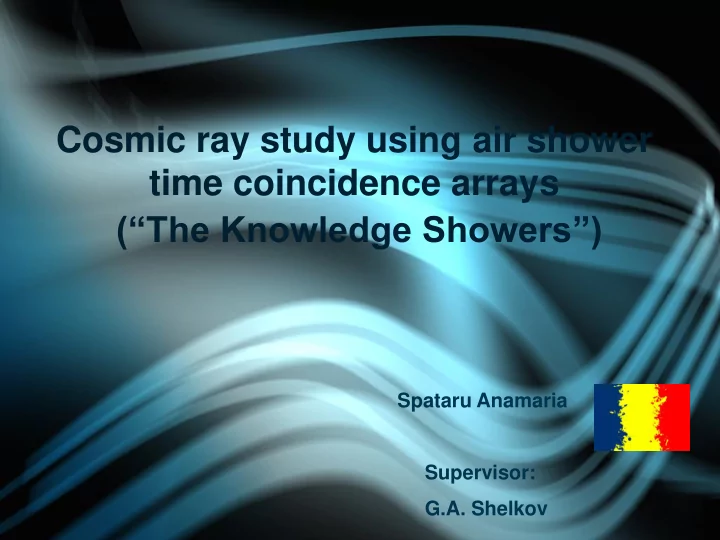

Cosmic ray study using air shower time coincidence arrays (“The Knowledge Showers”) Spataru Anamaria Supervisor: G.A. Shelkov
Table of contents Cosmic rays Setup Zenith angular dependence of muon intensity The dependence on the thickness of the material
On 7 August 1912, Victor Hess, discovered the cosmic rays Cosmic ray – the flux of particles arriving on Earth from outer space Composition: *80% protons *15% alpha particle *5 % heavier elements and antimatter
After entering the atmosphere, the primary cosmic rays interact with the nuclei and the molecules in the air creating pions, muons, beta particles, and gammas Muons are the main component of cosmic rays observed at the sea level
Setup 3 Counters: scintillater detectors ( consists of a material that • luminates when is ionized) photomultiplier tubes (multiplies the photon and convert it to an electric pulse) • QuarkNet DAQ board: takes the signal from the counters and produces the output data
Zenith angular dependence of muon intensity • the intensity is decreasing as the angle is increasing • can be expressed as I (θ) = I (0◦)cos^2(θ)
Measurements: θ(◦ ) No. of Time (s) Rate counts (N) (counts/s) 118 ± 11 0 6460 1.826 85 ± 9 30 6430 1.321 54 ± 7 45 6840 0.789 372 ± 19 60 68105 0.546 90 82265 0.209 172 ± 13
the flux is decreasing with the zenith angle
The dependence on the thickness of the material Measurements: Material Thickness No. of Time Rate particles (mm) (s) (counts/ s) 9078 3865 2.35 Pb 1.9 2997 1210 2.48 Pb 4.6 3212 1205 2.67 Pb 7.65 3189 1230 2.59 Pb 10.65 3068 1220 2.51 Pb 15.35 2977 1225 2.43 Pb 45 2904 1370 2.12 Pb 98.65 2615 1220 2.14
Material Thickness No. of Time Rate particles (mm) (s) (counts/ s) 3047 1215 2.51 Al 1.35 3475 1360 2.56 Al 5.4 3361 1250 2.69 Al 9.1 3415 1250 2.73 Al 16.5 6026 2295 2.63 Al 31.5 3252 1220 2.67 Al 40.5 3177 2.64 1205 Al 125 3322 2.53 1315
Thank you for your attention!
Recommend
More recommend